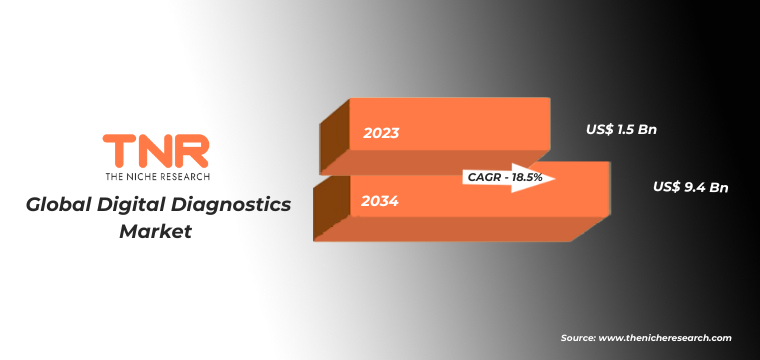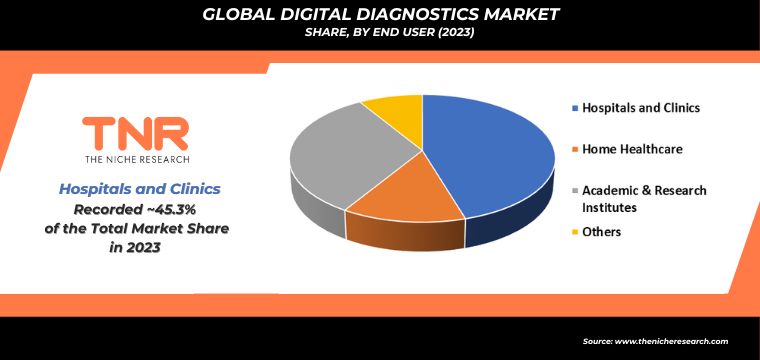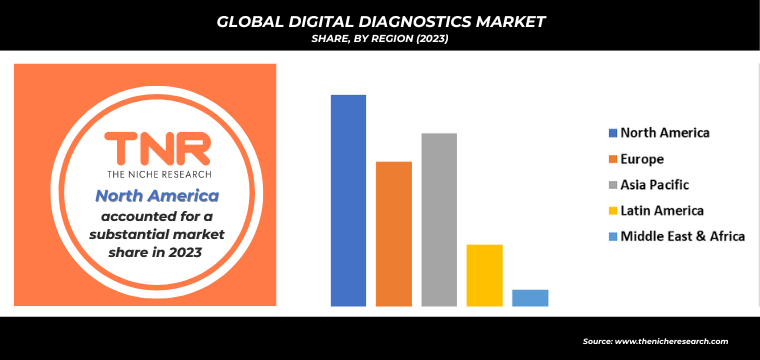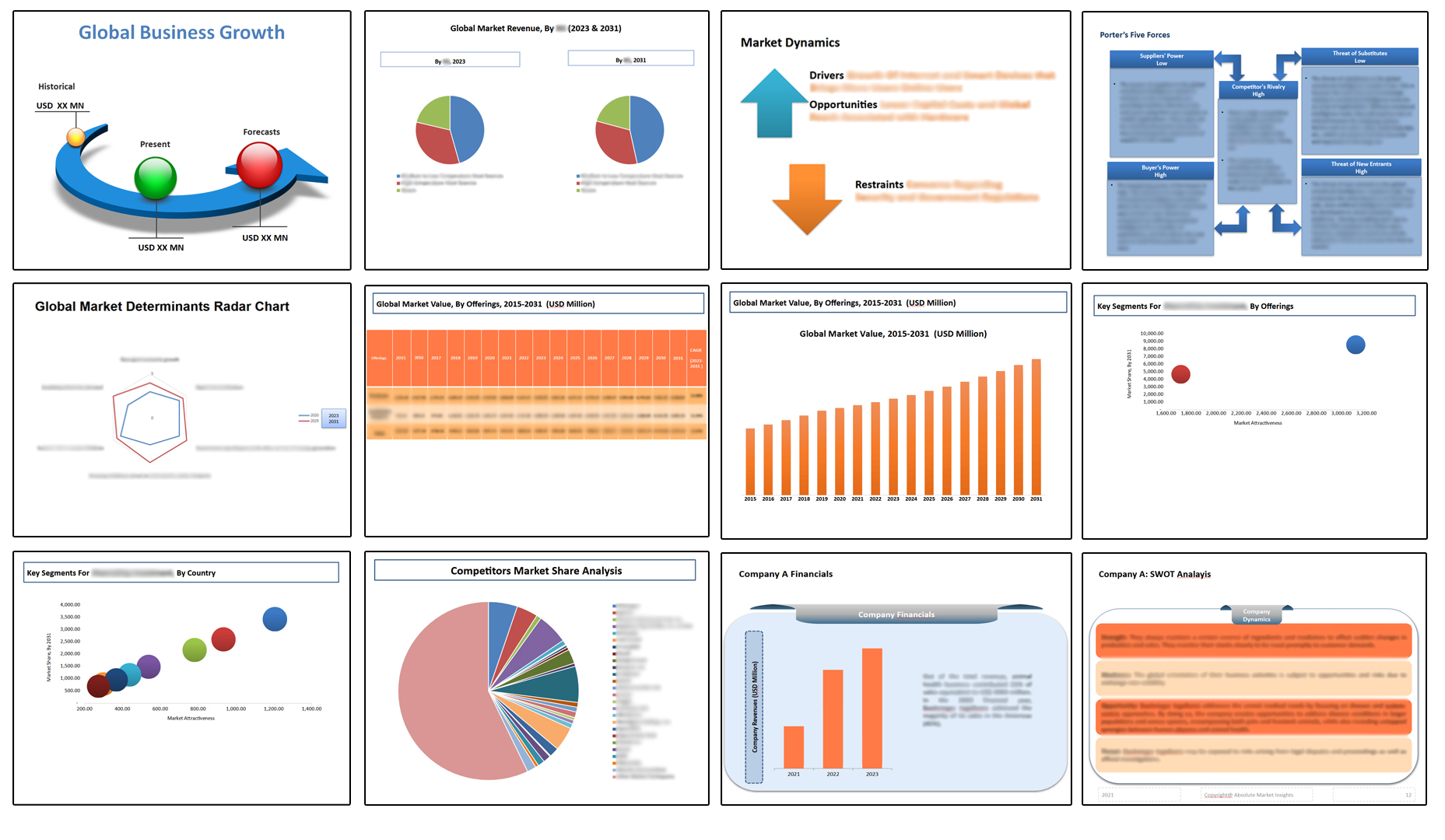Global Digital Diagnostics Market, By Product Type, By Application, By End User, By Region & Segmental Insights Trends and Forecast, 2024 – 2034
- Industry: Healthcare
- Report ID: TNR-110-1322
- Number of Pages: 420
- Table/Charts : Yes
- October, 2024
- Base Year : 2024
- No. of Companies : 10+
- No. of Countries : 29
- Views : 10049
- Covid Impact Covered: Yes
- War Impact Covered: Yes
- Formats : PDF, Excel, PPT
Digital diagnostics refers to the use of digital technologies to analyze health data and provide diagnostic insights. This approach leverages AI, machine learning, and mobile health platforms to deliver real-time, accurate, and non-invasive diagnostics. The global digital diagnostics market is experiencing rapid growth due to rising demand for early disease detection and the increasing adoption of telemedicine.
One key example is the use of wearable devices like the Apple Watch, which monitors heart rates and alerts users to irregularities. Another example is Abbott’s FreeStyle Libre, a glucose monitoring system for diabetic patients. “In Terms of Revenue, the Global Digital Diagnostics Market was Worth US$ 1.5 Bn in 2023, Anticipated to Witness CAGR of 18.5% During 2024 – 2034.” The importance of digital diagnostics lies in its potential to improve patient outcomes by enabling continuous health monitoring, reducing diagnostic errors, and enhancing access to healthcare in remote areas.

| Application | Uses of Digital Diagnostics | Examples |
| Cardiology | Digital diagnostics in cardiology focus on early detection and monitoring of heart-related diseases like arrhythmia, heart failure, and coronary artery disease. AI-powered ECGs, wearable heart monitors, and telecardiology are widely used for real-time tracking of cardiac health. | In 2023, devices like the Apple Watch Series 8 and KardiaMobile offer continuous heart rhythm monitoring. AI-based platforms, such as GE Healthcare’s Edison, enhance diagnostic accuracy by analyzing vast amounts of cardiac data. |
| Gynaecology | Digital tools in gynecology assist in monitoring pregnancy, detecting fetal abnormalities, and diagnosing reproductive health issues like PCOS and cervical cancer. Ultrasound devices, digital colposcopy, and AI-enhanced imaging are commonly used. | In 2023, Philips’ AI-powered ultrasound systems for obstetrics provide real-time fetal assessments, while devices like Ava Fertility Tracker offer digital solutions for ovulation monitoring and reproductive health. |
| Infectious Diseases | Digital diagnostics for infectious diseases enable rapid testing and real-time monitoring of diseases like COVID-19, tuberculosis, and HIV. Remote diagnostics, telemedicine, and AI-powered platforms accelerate detection and treatment. | In 2021, digital PCR tests and AI tools like Qure.ai have been instrumental in diagnosing COVID-19. Abbott’s ID NOW, a portable molecular testing device, provides rapid results for infectious diseases like influenza and COVID-19. |
| Oncology | Digital diagnostics revolutionize cancer detection through AI-powered imaging, liquid biopsy tests, and wearable tech for real-time monitoring of tumor markers and treatment response. These tools help in early diagnosis and personalized treatment plans. | In 2023, AI-based diagnostic platforms like PathAI assist in identifying cancerous cells with greater accuracy. Liquid biopsies from companies like Guardant Health help detect cancer early through non-invasive blood tests. |
| Diabetes | Diabetes management is enhanced through continuous glucose monitoring (CGM) systems, AI-driven analytics, and mobile apps for real-time blood sugar tracking and insulin management. Remote monitoring solutions enable better care coordination. | Devices like Dexcom G6 and Abbott’s FreeStyle Libre 3 offer continuous glucose monitoring, while AI-based platforms such as Glooko help patients manage diabetes by integrating data from CGMs and insulin pumps. |
| Others | Digital diagnostics are applied in fields such as neurology, pulmonology, and gastrointestinal health. Telemedicine platforms, AI-powered diagnostics, and portable devices allow for remote monitoring and personalized care in these areas. | In 2023, telehealth platforms like Teladoc and digital diagnostics like Propeller Health’s smart inhalers for asthma management provide significant advancements in personalized, remote healthcare delivery across various conditions. |
Growth Drivers in the Global Digital Diagnostics Market
- Rising Adoption of AI and Machine Learning in Healthcare: The growing integration of AI and machine learning in diagnostics is significantly driving the global digital diagnostics market. For instance, AI-powered platforms like PathAI assist pathologists in diagnosing diseases like cancer more accurately. Additionally, Zebra Medical Vision uses AI for imaging analysis, helping radiologists detect abnormalities early. This trend is set to expand through 2030.
- Increased Demand for Remote Patient Monitoring: The global demand for remote patient monitoring, particularly after the COVID-19 pandemic, has surged, fueling growth in digital diagnostics. Devices such as wearable ECG monitors and continuous glucose monitors, like Dexcom’s G6, allow real-time health tracking. This need for remote diagnostics, especially in chronic disease management, is expected to drive market expansion through 2034.
Restraints in the Global Digital Diagnostics Market
- Data Privacy and Security Concerns: The global digital diagnostics market faces challenges due to data privacy and security concerns. Sensitive health data collected through devices like wearable monitors and mobile apps can be vulnerable to cyberattacks. For example, breaches in systems such as LabCorp (2019) raised concerns over patient data safety, hindering trust and market adoption through 2034.
- High Costs of Digital Diagnostic Technologies: The high initial costs of advanced digital diagnostic technologies present a major restraint. For instance, AI-based diagnostic platforms or wearable devices like Apple Watch and FreeStyle Libre are often expensive for healthcare providers and patients. This cost barrier limits widespread adoption, particularly in developing regions, affecting market growth between 2023 and 2034.
Global Digital Diagnostics Market Segmental Analysis:
Diagnostic imaging has emerged as the dominant source in the global digital diagnostics market, accounting for 30.2% of revenue share. This dominance stems from its widespread application in detecting diseases and monitoring treatments. For instance, technologies like MRI, CT scans, and X-rays are essential in diagnosing conditions such as cancer, cardiovascular diseases, and bone fractures. The integration of AI in imaging further enhances accuracy and efficiency, aiding in early detection. An example is Siemens Healthineers’ AI-powered imaging systems, which have improved diagnostic speed. Additionally, the rise of telehealth has amplified demand for remote diagnostics using imaging tools.

In 2023, the diabetes segment secured its position as the second-largest application category in the global digital diagnostics market, with a revenue share of 20.6%. This growth is driven by the increasing prevalence of diabetes worldwide and the adoption of digital health tools for disease management. For instance, continuous glucose monitors (CGMs) like Dexcom and Abbott’s FreeStyle Libre have transformed diabetes care by offering real-time glucose level tracking. These innovations help patients and healthcare providers make informed decisions about treatment. Additionally, AI-driven platforms such as Glooko integrate data from glucose monitors and insulin pumps to offer comprehensive insights, enhancing patient outcomes and improving overall diabetes management efficiency.

Home healthcare segment is projected to be the fastest-growing end user category in the global digital diagnostics market, expected to hold a substantial 13.5% revenue share. This surge is fueled by the increasing demand for remote healthcare services and the convenience of at-home diagnostics. For example, portable devices like blood pressure monitors, pulse oximeters, and glucose meters enable patients to manage chronic conditions without frequent hospital visits. Additionally, platforms like TytoCare allow patients to conduct digital health exams from home, providing real-time data to physicians. The growing aging population and advancements in telemedicine further boost the adoption of home-based digital diagnostics solutions.

In 2023, Europe reinforced its third leading position in the global digital diagnostics market, capturing a significant revenue share of 23.6%. This growth is driven by the region’s advanced healthcare infrastructure, widespread adoption of digital technologies, and robust governmental support. For instance, countries like Germany and the UK have embraced telemedicine and digital diagnostic tools like AI-based imaging and remote patient monitoring systems. Philips, a major European healthcare company, has been instrumental in advancing digital diagnostics through its AI-powered solutions, such as IntelliSpace Portal, which supports clinical decision-making. Additionally, Europe’s aging population and increasing demand for efficient healthcare solutions further bolster market expansion.

Competitive Landscape
Some of the players operating in the digital diagnostics market are
- Cerora
- Digital Diagnostics Inc.
- GE Healthcare
- Hoffmann-La Roche Ltd.
- Laboratory Corporation of America Holdings
- Midmark Corporation
- Riverain Technologies
- Siemens Healthcare GmbH
- ThermoFisher Scientific Inc.
- Other Industry Participants
Global Digital Diagnostics Market Scope:
| Report Specifications | Details |
| Market Revenue in 2023 | US$ 1.5 Bn |
| Market Size Forecast by 2034 | US$ 9.4 Bn |
| Growth Rate (CAGR) | 18.5% |
| Historic Data | 2016 – 2022 |
| Base Year for Estimation | 2023 |
| Forecast Period | 2024 – 2034 |
| Report Inclusions | Market Size & Estimates, Market Dynamics, Competitive Scenario, Trends, Growth Factors, Market Determinants, Key Investment Segmentation, Product/Service/Solutions Benchmarking |
| Segments Covered | By Product Type, By Application, By End User, By Region |
| Regions Covered | North America, Europe, Asia Pacific, Middle East & Africa, Latin America |
| Countries Covered | U.S., Canada, Mexico, Rest of North America, France, The UK, Spain, Germany, Italy, Nordic Countries (Denmark, Finland, Iceland, Sweden, Norway), Benelux Union (Belgium, The Netherlands, Luxembourg), Rest of Europe, China, Japan, India, New Zealand, Australia, South Korea, Southeast Asia (Indonesia, Thailand, Malaysia, Singapore, Rest of Southeast Asia), Rest of Asia Pacific, Saudi Arabia, UAE, Egypt, Kuwait, South Africa, Rest of Middle East & Africa, Brazil, Argentina, Rest of Latin America |
| Key Players | Cerora, Digital Diagnostics Inc., GE Healthcare, Hoffmann-La Roche Ltd., Laboratory Corporation of America Holdings, Midmark Corporation, Riverain Technologies, Siemens Healthcare GmbH, ThermoFisher Scientific Inc. |
| Customization Scope | Customization allows for the inclusion/modification of content pertaining to geographical regions, countries, and specific market segments. |
| Pricing & Procurement Options | Explore purchase options tailored to your specific research requirements |
| Contact Details | Consult With Our Expert
Japan (Toll-Free): +81 663-386-8111 South Korea (Toll-Free): +82-808- 703-126 Saudi Arabia (Toll-Free): +966 800-850-1643 United Kingdom: +44 753-710-5080 United States: +1 302-232-5106 E-mail: askanexpert@thenicheresearch.com
|
Global Digital Diagnostics Market
By Product Type
- Diagnostic Imaging
- X-ray
- MRI
- Ultrasound
- CT Scans
- In Vitro Diagnostics (IVD)
- Biomarker Testing
- Genetic Testing
- Others
By Application
- Cardiology
- Gynecology
- Infectious Diseases
- Oncology
- Diabetes
- Others
By End User
- Hospitals and Clinics
- Home Healthcare
- Academic & Research Institutes
- Others
By Region
- North America (U.S., Canada, Mexico, Rest of North America)
- Europe (France, The UK, Spain, Germany, Italy, Nordic Countries (Denmark, Finland, Iceland, Sweden, Norway), Benelux Union (Belgium, The Netherlands, Luxembourg), Rest of Europe)
- Asia Pacific (China, Japan, India, New Zealand, Australia, South Korea, Southeast Asia (Indonesia, Thailand, Malaysia, Singapore, Rest of Southeast Asia), Rest of Asia Pacific)
- Middle East & Africa (Saudi Arabia, UAE, Egypt, Kuwait, South Africa, Rest of Middle East & Africa)
- Latin America (Brazil, Argentina, Rest of Latin America)
Report Layout:

Table of Contents
Note: This ToC is tentative and can be changed according to the research study conducted during the course of report completion.
**Exclusive for Multi-User and Enterprise User.
Global Digital Diagnostics Market
By Product Type
- Diagnostic Imaging
- X-ray
- MRI
- Ultrasound
- CT Scans
- In Vitro Diagnostics (IVD)
- Biomarker Testing
- Genetic Testing
- Others
By Application
- Cardiology
- Gynecology
- Infectious Diseases
- Oncology
- Diabetes
- Others
By End User
- Hospitals and Clinics
- Home Healthcare
- Academic & Research Institutes
- Others
By Region
- North America (U.S., Canada, Mexico, Rest of North America)
- Europe (France, The UK, Spain, Germany, Italy, Nordic Countries (Denmark, Finland, Iceland, Sweden, Norway), Benelux Union (Belgium, The Netherlands, Luxembourg), Rest of Europe)
- Asia Pacific (China, Japan, India, New Zealand, Australia, South Korea, Southeast Asia (Indonesia, Thailand, Malaysia, Singapore, Rest of Southeast Asia), Rest of Asia Pacific)
- Middle East & Africa (Saudi Arabia, UAE, Egypt, Kuwait, South Africa, Rest of Middle East & Africa)
- Latin America (Brazil, Argentina, Rest of Latin America)
The Niche Research approach encompasses both primary and secondary research methods to provide comprehensive insights. While primary research is the cornerstone of our studies, we also incorporate secondary research sources such as company annual reports, premium industry databases, press releases, industry journals, and white papers.
Within our primary research, we actively engage with various industry stakeholders, conducting paid interviews and surveys. Our meticulous analysis extends to every market participant in major countries, allowing us to thoroughly examine their portfolios, calculate market shares, and segment revenues.
Our data collection primarily focuses on individual countries within our research scope, enabling us to estimate regional market sizes. Typically, we employ a bottom-up approach, meticulously tracking trends in different countries. We analyze growth drivers, constraints, technological innovations, and opportunities for each country, ultimately arriving at regional figures.Our process begins by examining the growth prospects of each country. Building upon these insights, we project growth and trends for the entire region. Finally, we utilize our proprietary model to refine estimations and forecasts.
Our data validation standards are integral to ensuring the reliability and accuracy of our research findings. Here’s a breakdown of our data validation processes and the stakeholders we engage with during our primary research:
- Supply Side Analysis: We initiate a supply side analysis by directly contacting market participants, through telephonic interviews and questionnaires containing both open-ended and close-ended questions. We gather information on their portfolios, segment revenues, developments, and growth strategies.
- Demand Side Analysis: To gain insights into adoption trends and consumer preferences, we reach out to target customers and users (non-vendors). This information forms a vital part of the qualitative analysis section of our reports, covering market dynamics, adoption trends, consumer behavior, spending patterns, and other related aspects.
- Consultant Insights: We tap into the expertise of our partner consultants from around the world to obtain their unique viewpoints and perspectives. Their insights contribute to a well-rounded understanding of the markets under investigation.
- In-House Validation: To ensure data accuracy and reliability, we conduct cross-validation of data points and information through our in-house team of consultants and utilize advanced data modeling tools for thorough verification.
The forecasts we provide are based on a comprehensive assessment of various factors, including:
- Market Trends and Past Performance (Last Five Years): We accurately analyze market trends and performance data from preceding five years to identify historical patterns and understand the market’s evolution.
- Historical Performance and Growth of Market Participants: We assess the historical performance and growth trajectories of key market participants. This analysis provides insights into the competitive landscape and individual company strategies.
- Market Determinants Impact Analysis (Next Eight Years): We conduct a rigorous analysis of the factors that are projected to influence the market over the next eight years. This includes assessing both internal and external determinants that can shape market dynamics.
- Drivers and Challenges for the Forecast Period:Identify the factors expected to drive market growth during the forecast period, as well as the challenges that the industry may face. This analysis aids in deriving an accurate growth rate projection.
- New Acquisitions, Collaborations, or Partnerships: We keep a close watch on any new acquisitions, collaborations, or partnerships within the industry. These developments can have a significant impact on market dynamics and competitiveness.
- Macro and Micro Factors Analysis:A thorough examination of both macro-level factors (e.g., economic trends, regulatory changes) and micro-level factors (e.g., technological advancements, consumer preferences) that may influence the market during the forecast period.
- End-User Sentiment Analysis: To understand the market from the end-user perspective, we conduct sentiment analysis. This involves assessing the sentiment, preferences, and feedback of the end-users, which can provide valuable insights into market trends.
- Perspective of Primary Participants: Insights gathered directly from primary research participants play a crucial role in shaping our forecasts. Their perspectives and experiences provide valuable qualitative data.
- Year-on-Year Growth Trend: We utilize a year-on-year growth trend based on historical market growth and expected future trends. This helps in formulating our growth projections, aligning them with the market’s historical performance.
Research process adopted by TNR involves multiple stages, including data collection, validation, quality checks, and presentation. It’s crucial that the data and information we provide add value to your existing market understanding and expertise. We have also established partnerships with business consulting, research, and survey organizations across regions and globally to collaborate on regional analysis and data validation, ensuring the highest level of accuracy and reliability in our reports.









